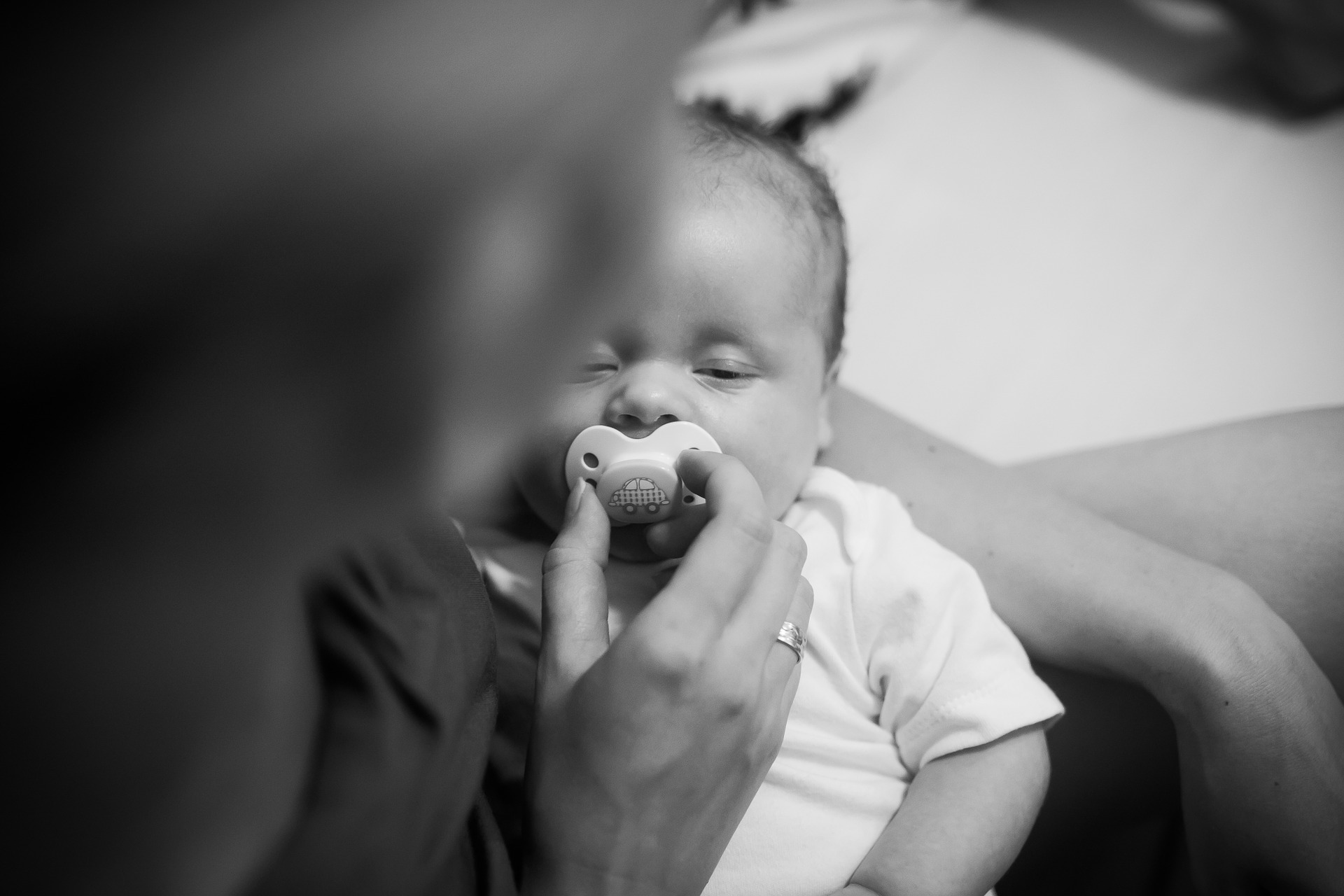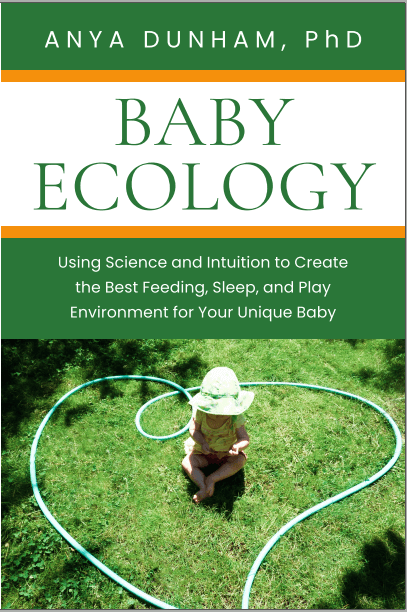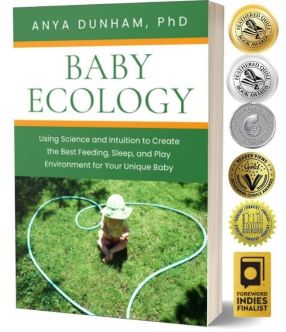Baby Ecology book is here! Learn more
Baby Ecology book is here!
- Home
- Help baby sleep
- Should Baby Sleep With Pacifier
Should baby sleep with a pacifier?
by Anya Dunham, PhD
Research suggests that during baby’s first year, pacifier use is more a matter of preference than a health decision.

Babies are born with a powerful need to suck. Even in the womb, many babies suck on their fingers and toes.
And so pacifiers, in one form or another, have been around for thousands of years. The current form of the pacifier emerged in patents in the early 1900s, but soothing rings and teats made from linen rags stuffed with sugar have been documented in the medical literature from the 15th century.
Today, however, some parents feel uneasy about offering their baby a pacifier (also called 'soother', 'binky', and 'dummy' – see how even some of the names carry a negative connotation?). Let’s take a look at what science says about pacifier use during baby’s first year.
Pacifier use and breastfeeding
Several scientific studies looked at whether pacifier use affects whether and for how long babies are breastfed for – and found no association.1,2
Another study reported that when mothers were highly motivated to breastfeed, prevalence or duration of breastfeeding was not affected regardless of whether pacifier use was encouraged or discouraged by medical professionals.3
Breastfeeding experts generally recommend waiting to introduce the pacifier until after breastfeeding is fully established (usually around 4 weeks).
Pacifiers and SIDS
Analyses of published case-control studies show that pacifier use during sleep is associated with a significant decrease in Sudden Infant Death Syndrome (SIDS).4,5 These results come from many countries around the world and are remarkably consistent.
Exactly how pacifiers reduce the risk of SIDS is unknown. Scientists hypothesize that it may be because babies who use pacifiers tend to sleep on their backs and generally sleep lighter (so they wake easier if they have trouble breathing).5,6
In 2016 the AAP Task Force recommended that pacifiers be used for up to one year from birth, for night sleep and naps; for breastfeeding babies, pacifiers should be introduced after breastfeeding is well established.7
Pacifiers and sleep
A pacifier is likely to become baby's sleep association. Sleep associations, or sleep cues, are people, things, and events that a baby associates with going to sleep and getting back to sleep. When a baby wakes in the middle of the night she tends to look for the sleep associations and cues she experienced at bedtime.
For example, a baby who bed-shares and falls asleep next to a parent will likely expect to find a parent next to her in the middle of the night. If she always goes to sleep nursing, she will likely want to nurse when she wakes. And a baby who falls asleep with a pacifier will likely look for it in the middle of the night.
Is this a problem? It may or may not be. One of the best things you can do to guide your baby towards sound sleep is developing soothing and consistent routines around sleep.
A simple and soothing bedtime routine for 8-month-old Kylee includes quiet play time with Daddy followed by a bath, feeding, lights out, cuddle, and a song as Mommy places her into her crib before leaving the room. When Kylee wakes up in the middle of the night, the room is still dark, quiet, and the smells and feel of the space are the same as when she went to sleep; if she is hungry, she calls out, and if not, she goes back to sleep. Kylee’s nap routine is a shorter version of the same general sequence: her nanny draws curtains in, gives her a hug, and sings a song.
In addition to being soothing and consistent for your baby, sleep routines must be sustainable for you: they must be something you are able to do, keep up with, and ideally enjoy every day (and night). A baby younger than 6-8 months is usually unable to find and re-insert a lost pacifier by himself, so he will need your help when he wakes in the middle of the night. If this is okay with you, then offering your baby a pacifier at bedtime could be part of his usual sleep routine. But if replacing the pacifier at night will be challenging for you, you might want to not offer your baby a pacifier and help her create other sleep associations.
Conclusions: Should baby sleep with a pacifier?
Overall, research suggests that pacifier use is a matter of preference rather than a health decision.
If you decide to offer your baby a pacifier:
- Consider choosing one-piece pacifiers (so they don't come apart)
- If your baby is breastfed, introduce pacifier after breastfeeding is established
- Clean and inspect pacifiers for tears regularly
- Offer pacifier mainly (or only) for sleep during the first year7,8
- Don’t encourage pacifier use beyond baby's first year9
And last but not least, don’t use the pacifier as a go-to solution to calm your baby. Watch her carefully to see what she might be telling you so you can meet her needs and comfort her, building a strong bond between you.
You might also be interested in:
References
References
1. O'Connor NR, Tanabe KO, Siadaty MS, Hauck FR. (2009) Pacifiers and breastfeeding: a systematic review. Archives of pediatrics & adolescent medicine 163:378-82
2. Jaafar SH, Ho JJ, Jahanfar S, Angolkar M. (2016) Effect of restricted pacifier use in breastfeeding term infants for increasing duration of breastfeeding. Cochrane Database of Systematic Reviews CD007202
3. Jenik AG, Vain NE, Gorestein AN, Jacobi NE. (2009) Does the recommendation to use a pacifier influence the prevalence of breastfeeding? The Journal of Pediatrics 155(3):350-4.e1
4. Hauck FR, Omojokun OO, Siadary MS. (2005) Do pacifiers reduce the risk of sudden infant death syndrome? A meta-analysis. Pediatrics 116:e716-23
5. Mitchell EA, Blair PS, L’Hoir MP. (2006) Should pacifiers be recommended to prevent Sudden Infant Death Syndrome? Pediatrics 117 (5): 1755-8
6. Franco P, Scaillet S, Wermenbol V, Valente F, Groswasser J, Kahn A. (2000) The influence of a pacifier on infants’ arousals from sleep. The Journal of Pediatrics 136:775–779
7. Moon RY. (2016) Task force on sudden infant death syndrome. SIDS and other sleep-related infant deaths: evidence base for 2016 updated recommendations for a safe infant sleeping environment. Pediatrics 138: pii:e20162940
8. Nelson AM. (2012) A comprehensive review of evidence and current recommendations related to pacifier usage. Journal of Pediatric Nursing 27(6):690-9
9. Silveira LM, Prade LS, Ruedell AM, Haeffner LS, Weinmann AR. (2013) Influence of breastfeeding on children's oral skills. Revista de Saúde Pública 47(1):37-43
Using hundreds of scientific studies, Baby Ecology connects the dots to help you create the best environment for sleep, feeding, care, and play for your baby.
Warmly,
Anya


